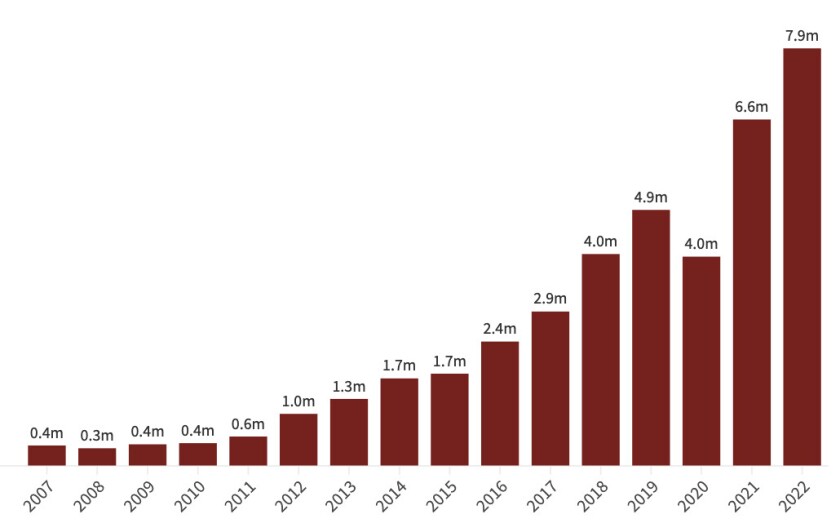Love it or hate it, Malört is Chicago’s drink.
Throwing back a shot of the bitter liquor is practically a rite of passage for many. If you stay long enough at any Chicago dive bar, you’re likely to see people order a Chicago Handshake: a shot of Malört with an Old Style beer.
Malört made its debut in Chicago in the 1920s, when Swedish immigrant Carl Jeppson began selling the traditional Swedish-style bitters on the Near North Side. Jeppson skirted Prohibition-era laws by selling his liquor as a tonic to cure stomach worms and parasites.
After Prohibition, Jeppson sold the recipe, and the first bottles of Malört were produced. In the mid 1940s, the liquor, which is similar to absinthe, was available in glass bottles with a stem of wormwood inside.
Malort developed a customer base, but it never really became popular. It wouldn’t win people over with its flavor.
So how did Malört go from being an obscure drink to, in some circles, a symbol of the city?
For years, bottles of the stuff sat on the back shelves of VFW halls and dive bars. Bartenders used it to prank people who asked for a free birthday shot.
Then, about 10 years ago, a Chicago bartender fell in love with the drink and made it his mission to make other people love it, too. What started as a semi-ironic gesture sent sales skyrocketing and helped bring about a revival of Malört, though not everyone is a fan. Rapper Drake recently posted a photo of the polarizing spirit with the caption, “There’s no way Chicago enjoys this ...”
Malört’s unlikely rise
In the late 2000s, Sam Mechling was a bouncer at a wine bar when a guy at work dared him to try Malört.
“He said [it] tasted like that junk drawer that everybody has in their kitchen, and that just seemed so insane to me,” Mechling said.
But as soon as Mechling tasted it, he knew the description wasn’t an exaggeration.
He started introducing it to friends at birthday parties and other gatherings. He became obsessed with seeing people’s first reactions, which have become known as “Malört face.” He began hosting Malört-themed trivia nights and comedy shows at bars.
He created Twitter and Facebook pages for Malört, which didn’t have its own accounts at the time, and documented people’s reactions to the drink. Those included phrases like “it tastes like the day Dad left,” “Malört, because Blagojevich wasn’t the worst thing that came out of Chicago” and “what soap washes its mouth with.”
As much fun as Mechling was having, he was spending his own money buying shots of Malört for people. He wanted to at least break even by selling T-shirts featuring the Malört logo, which he sold out of Paddy Long’s, a bar in Lakeview where he worked.
“In one day, 100 people came in to buy these Malört T-shirts,” said Pat Berger, owner of the now-defunct bar.
That caught the attention of Patty Gabelick, the brand’s then-owner.
Sales soar
Around 2012, Gabelick showed up, unannounced, with her lawyer at Paddy Long’s. The meeting was tense at first. Then, Mechling showed the visitors a letter he sent Gabelick months earlier, professing his love for Malört. He’d included a check with profits from T-shirt sales. The letter had been returned by the U.S. Postal Service.
That changed the mood. Gabelick offered Mechling a job.
“It was like going from thinking that I was going to be financially destroyed by this corporation to landing a dream job in the matter of five minutes,” Mechling said.
He worked for Malört nearly a decade. He continued to host events, but now they were endorsed. Malort sales jumped.
“That was the start of … Malört’s giant resurgence from just being available at VFW halls and the Green Mill to being in every hipster bar in Chicago,” Berger said.
In 2018, Tremaine Atkinson, chief executive officer and head distiller of Chicago’s CH Distillery, bought the company when Gabelick retired. Production of Malört had moved to Florida in the late 1980s, but, under Atkinson, it returned to Chicago in 2019.
Jeppson’s Malört shots
Chicago staple
Over the past five years, Malört spread from being available only in Illinois, Wisconsin, Indiana and Louisiana to being sold in 30 states.
“People like to say, ‘Oh, I hate Malört,’ but … you usually don’t come back to something unless you actually like it,” Atkinson said.
Mechling, who heads his own marketing company in Ohio, said Malört gave him more than he ever expected — including meeting his soon-to-be wife.
Now, he’s on the hunt for the next old and unwanted thing he can help make new and desirable again.
Adriana Cardona-Maguigad reports for WBEZ’s Curious City.
Contributing: Liz Garibay, Chicago Brewseum








